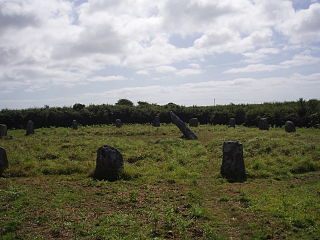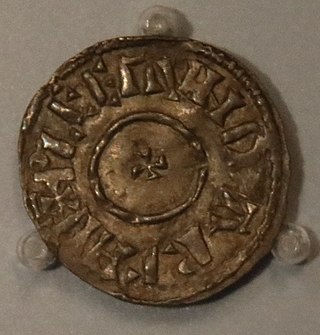Related Research Articles

Alfred the Great was King of the West Saxons from 871 to 886, and King of the Anglo-Saxons from 886 until his death in 899. He was the youngest son of King Æthelwulf and his first wife Osburh, who both died when Alfred was young. Three of Alfred's brothers, Æthelbald, Æthelberht and Æthelred, reigned in turn before him. Under Alfred's rule, considerable administrative and military reforms were introduced, prompting lasting change in England.

Æthelwulf was King of Wessex from 839 to 858. In 825, his father, King Ecgberht, defeated King Beornwulf of Mercia, ending a long Mercian dominance over Anglo-Saxon England south of the Humber. Ecgberht sent Æthelwulf with an army to Kent, where he expelled the Mercian sub-king and was himself appointed sub-king. After 830, Ecgberht maintained good relations with Mercia, and this was continued by Æthelwulf when he became king in 839, the first son to succeed his father as West Saxon king since 641.

Æthelbald was King of Wessex from 855 or 858 to 860. He was the second of five sons of King Æthelwulf. In 850, Æthelbald's elder brother Æthelstan defeated the Vikings in the first recorded sea battle in English history, but he is not recorded afterwards and probably died in the early 850s. The next year Æthelwulf and Æthelbald inflicted another defeat on the Vikings at the Battle of Aclea. In 855, Æthelwulf went on pilgrimage to Rome and appointed Æthelbald King of Wessex, while Æthelberht, the next oldest son, became King of Kent, which had been conquered by Wessex thirty years earlier.

Æthelberht was the King of Wessex from 860 until his death in 865. He was the third son of King Æthelwulf by his first wife, Osburh. Æthelberht was first recorded as a witness to a charter in 854. The following year Æthelwulf went on pilgrimage to Rome and appointed his oldest surviving son, Æthelbald, as king of Wessex while Æthelberht became king of the recently conquered territory of Kent. Æthelberht may have surrendered his position to his father when he returned from pilgrimage, but resumed the south-eastern kingship when his father died in 858.

Eadred was King of the English from 26 May 946 until his death. He was the younger son of Edward the Elder and his third wife Eadgifu, and a grandson of Alfred the Great. His elder brother, Edmund, was killed trying to protect his seneschal from an attack by a violent thief. Edmund's two sons, Eadwig and Edgar, were then young children, so Eadred became king. He suffered from ill health in the last years of his life and he died at the age of a little over thirty, having never married. He was succeeded successively by his nephews, Eadwig and Edgar.

Æthelstan or Athelstan was King of the Anglo-Saxons from 924 to 927 and King of the English from 927 to his death in 939. He was the son of King Edward the Elder and his first wife, Ecgwynn. Modern historians regard him as the first King of England and one of the "greatest Anglo-Saxon kings". He never married and had no children; he was succeeded by his half-brother, Edmund I.
Asser was a Welsh monk from St David's, Dyfed, who became Bishop of Sherborne in the 890s. About 885 he was asked by Alfred the Great to leave St David's and join the circle of learned men whom Alfred was recruiting for his court. After spending a year at Caerwent because of illness, Asser accepted.
Leofric was a medieval Bishop of Exeter. Probably a native of Cornwall, he was educated on the continent. At the time Edward the Confessor was in exile before his succession to the English throne, Leofric joined his service and returned to England with him. After he became king, Edward rewarded Leofric with lands. Although a 12th-century source claims Leofric held the office of chancellor, modern historians agree he never did so.
Ælfweard was the second son of Edward the Elder, the eldest born to his second wife Ælfflæd.

Dumnonia is the Latinised name for a Brythonic kingdom that existed in Sub-Roman Britain between the late 4th and late 8th centuries CE in the more westerly parts of present-day South West England. It was centred in the area of modern Devon, but also included modern Cornwall and part of Somerset, with its eastern boundary changing over time as the gradual westward expansion of the neighbouring Anglo-Saxon kingdom of Wessex encroached on its territory. The spelling Damnonia is sometimes encountered, but that spelling is also used for the land of the Damnonii, later part of the Kingdom of Strathclyde, in present-day southern Scotland. The form Domnonia also occurs and shares a linguistic relationship with the Breton region of Domnonée.

The history of Cornwall goes back to the Paleolithic, but in this period Cornwall only had sporadic visits by groups of humans. Continuous occupation started around 10,000 years ago after the end of the last ice age. When recorded history started in the first century BCE, the spoken language was Common Brittonic, and that would develop into Southwestern Brittonic and then the Cornish language. Cornwall was part of the territory of the tribe of the Dumnonii that included modern-day Devon and parts of Somerset. After a period of Roman rule, Cornwall reverted to rule by independent Romano-British leaders and continued to have a close relationship with Brittany and Wales as well as southern Ireland, which neighboured across the Celtic Sea. After the collapse of Dumnonia, the remaining territory of Cornwall came into conflict with neighbouring Wessex.

Devon is a county in south west England, bordering Cornwall to the west with Dorset and Somerset to the east. There is evidence of occupation in the county from Stone Age times onward. Its recorded history starts in the Roman period when it was a civitas. It was then a separate kingdom for a number of centuries until it was incorporated into early England. It has remained a largely agriculture based region ever since though tourism is now very important.
Jænberht was a medieval monk, and later the abbot, of St Augustine's Abbey, Canterbury, who was named Archbishop of Canterbury in 765. As archbishop, he had a difficult relationship with King Offa of Mercia, who at one point confiscated lands from the archbishopric. By 787, some of the bishoprics under Canterbury's supervision were transferred to the control of the newly created Archbishopric of Lichfield, although it is not clear if Jænberht ever recognised its legitimacy. Besides the issue with Lichfield, Jænberht also presided over church councils in England. He died in 792 and was considered a saint after his death.

The Bishop of Exeter is the ordinary of the Church of England Diocese of Exeter in the Province of Canterbury. The See has been vacant since Robert Atwell's retirement on 30 September 2023.

Plegmund was a medieval English Archbishop of Canterbury. He may have been a hermit before he became archbishop in 890. As archbishop, he reorganised the Diocese of Winchester, creating four new sees, and worked with other scholars in translating religious works. He was canonised after his death.

Edward the Elder was King of the Anglo-Saxons from 899 until his death in 924. He was the elder son of Alfred the Great and his wife Ealhswith. When Edward succeeded to the throne, he had to defeat a challenge from his cousin Æthelwold, who had a strong claim to the throne as the son of Alfred's elder brother and predecessor, Æthelred I.
Ealhstan was a medieval Bishop of Sherborne.
Heahmund was a medieval Bishop of Sherborne. He was a warrior-bishop and he was killed fighting against the Danes for the Anglo-Saxon King Æthelred I of Wessex and his brother Alfred.
The Battle of Hehil was a battle won by a force of Britons, probably against the Anglo-Saxons of Wessex around the year 720. The location is unknown, except that it was apud Cornuenses.

The Battle of Hingston Down took place in 838, probably at Hingston Down in Cornwall between a combined force of Cornish and Vikings on the one side, and West Saxons led by Ecgberht, King of Wessex on the other. The result was a West Saxon victory. According to the Anglo-Saxon Chronicle, which called the Cornish the West Welsh:
References
- ↑ Orme, Nicholas (2000). The Saints of Cornwall. Oxford University Press. pp. 8–9. ISBN 9780191542893.
- ↑ Keynes, Simon (2014) [1st edition 1999]. "Asser". In Lapidge, Michael; Blair, John; Keynes, Simon; Scragg, Donald (eds.). The Wiley Blackwell Encyclopedia of Anglo-Saxon England (Second ed.). Chichester, West Sussex: Wiley Blackwell. p. 51. ISBN 978-0-470-65632-7.
- ↑ Stenton, Frank (1971). Anglo-Saxon England (3rd ed.). Oxford University Press. p. 439. ISBN 978-0-19-821716-9.
- ↑ Crockford's Clerical Directory , 100th edition, (2007), Church House Publishing. ISBN 978-0-7151-1030-0.
- 1 2 Fryde, E. B.; Greenway, D. E.; Porter, S.; Roy, I., eds. (1986). Handbook of British Chronology (3rd, reprinted 2003 ed.). Cambridge: Cambridge University Press. p. 215. ISBN 0-521-56350-X.
- ↑ Charles-Edwards, T. M. (2013). Wales and the Britons 350–1064. Oxford, UK: Oxford University Press. p. 431. ISBN 978-0-19-821731-2.
- ↑ Exeter: Ecclesiastical History Archived 1 October 2006 at the Wayback Machine . Retrieved on 8 December 2008.